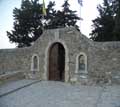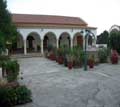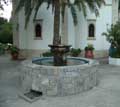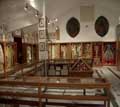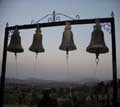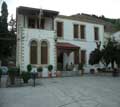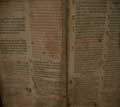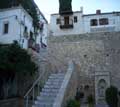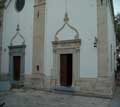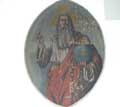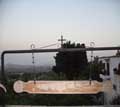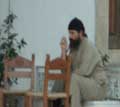
The Holy Monastery of Agios Georgios Apanosifis or Apanosifis is located approximately in the center of the prefecture of Heraklion and Crete in general. It is the largest monastery since its foundation in Crete in terms of number of Monks, not only registered but also those who left. The Monastery was built during the last years of the Venetian occupation and gained such fame that in the following years it became one of the biggest pilgrimages in Crete. The exact time of the establishment of the Monastery remains unknown. Prof. Tomadakis classifies it among the Monasteries that functioned during the Venetian occupation. Also, those who dealt with the history of the Monastery place its foundation in the middle or the end of the 17th century.
During the period of the Turkish invasion (1645-1669), the Epanosifi Monastery is in its first steps and has acquired its first important assets. During that difficult time for Crete, the Monastery began to develop. The Monastery is often mentioned in the documents of the Turkish archive of Heraklion translated by Nikolaos Stavrinidis. The first reference is made in 1672. Mehmet Veys son Hasan, who was in the service of Governor Handakos, had entrusted a forvada to the monk of the Monastery of Agios Georgios Germanos. During this period, donations and dedications of estates are a common event for the Monastery. In 1697 the Monastery was at the center of a legal dispute. A Turk was found murdered outside the Monastery. The family of the Turk considered the monks suspicious, asking them to pay the blood tax and to apply the provision provided by the Holy Law. This document mentions 13 names of Monks who lived in Epanosifi at that time. This shows that the Monastery had become a great monastic center.
The spiritual and social contribution of the Monastery during the interspersed years of the Turkish occupation is priceless. He helped the trekkers but also the tested people of Crete. He maintained a school and a rich library. And at the same time learned Monks lived in the Monastery, who developed activity either as copyists of books, or as hymn writers, or as teachers. At the end of the 18th century important personalities lived in the Monastery, such as Synesios o Kris and Georgios Gounales.
Shares and property of the Monastery exist almost all over Crete. The metochi Aistratagos, which is located NW of the Monastery. It functioned as a Monastery during the last years of the Venetian rule. It was probably founded in the 10th or 11th century by Nikephoros Phokas. Today the Church is preserved with frescoes from the 14th century and some one-story houses. At a distance of two kilometers from the Monastery is the metochi of Agios Antonios. Today the church is preserved with frescoes from the 14th century and ruins of cells. Another share is of Dry Woods in the area of Meramvello. It was founded during the first years of the Turkish conquest. Other shares are: a) Lazaretto in Partheni, b) of Merthiotis, c) of Kapella near Roukani, d) of Mustafa Bey, in Vathypetro Archanon and e) Rimabela.
The offer of the Epanosifi Monastery is immeasurable. As an example, we mention that the current Higher Ecclesiastical School of Crete, the Orphanage and the building that houses the R\S of the First Archdiocese of Crete were built on a plot of land of the Monastery and at its own expense. The Spiritual Center of I.A. Crete was built with the proceeds of the Monastery. The Nursing Home in St. Ioannis, in a suburb of Heraklion, it was started by one of the brothers of the Monastery, blessed Paisios Houdetsanakis. He also helped significantly in the construction of the Metropolitan Church of Agios Minas and the buildings of the Archdiocese.
Source: MUNICIPALITY OF ARHANON - ASTEROUSION
www.dimos-archanon-asterousion.gr










